






 |
||||
 |
 |
 |
 |
 |
 |
||||
|
Anatomy of an Art Form
By Dale Keiger |
|
| Medical images used in opening illustration supplied courtesy of Art as Applied to Medicine faculty. |
David J. Blum is a potter, a painter, a photographer. He's
a visual guy who lately has been working to create a visual
representation of something that can't be seen. ATP
synthase is an enzyme that makes adenosine triphosphate
(ATP), the fuel that powers all the cellular processes of
the human body. Research on this enzyme has yielded vast
quantities of data, Nobel Prizes for three scientists, and
X-ray crystallographic images. But none of these things
tell scientists what the ATP synthase molecule looks like
in action. Enter Mr. Blum. To understand how something works, it helps to be able to see it. In 2000, as a graduate student in Hopkins' Art as Applied to Medicine program, Blum set about using a computer to show ATP synthase in action. Each molecule resembles a mushroom, with a head, stem, and base, but is really a nano-machine, a rotor that works as an infinitesimal generator. Scientists believe that the stem, powered by protons, rotates about 130 times per second, inducing elements of the head to chemically process phosphate and adenosine diphosphate and thus produce ATP. An enzyme's function is based on both its structure and its movement. X-ray crystallography could define the structure of ATP synthase in one static snapshot, but the motion of the actual chemical reaction was still unrepresentable. Blum conferred with Hopkins researchers and dug deeply into the science — so deeply that he's now a PhD candidate in biological chemistry. He also learned three-dimensional computer animation and on a Dell workstation created an animated movie of ATP synthase in action, a model that was simple enough to be visually comprehensible but true to the latest science. "In the past, most biologists and biochemists have visualized much of what they study with a one-dimensional static view, even though the inner workings of cells involve three dimensions and dynamic action all the time," says Peter L. Pedersen, Hopkins professor of biological chemistry and one of the leading researchers working on ATP synthase. "The ATP synthase is an incredibly important enzyme, perhaps the most important in the universe, and we just have to know how this wonderful nano-machine works. We cannot afford to remain in a one-dimensional static world of thought. With David's help, we were able to use known structural and functional information to visualize how ATP synthase works dynamically and in three dimensions."
Using digital technology to illustrate science and medicine
and to give visual form to what cannot be seen is the
latest thrust of a School of Medicine department founded in
1911 by German émigré Max Brödel. Only
six accredited programs in medical illustration exist in
North America, and Johns Hopkins' is the oldest. The dozen
or so graduate students in the program, many of whom were
undergraduate science or pre-med majors who never lost a
desire to work as artists, spend two years studying a
unique amalgam of fine arts and science. They attend class
in anatomy, organ histology, principles of pathology,
embryology, anatomical dissection, and a variety of
artistic techniques. |
| David Blum's 3-D computer animation of ATP synthase (pictured below) enabled scientists to visually comprehend the chemical reaction for the first time. Blum became so immersed in the science while creating the model that he is now a PhD candidate in biological chemistry. |
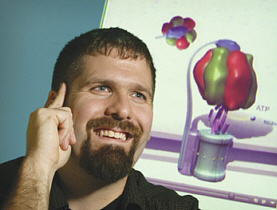 For more than 75 of its 92 years, the department's work has
been a traditional art of pencil, pen, brush, and board,
teaching students how to render, with superb craftsmanship
and accuracy, the body's constituent parts, the processes
of pathology, and the surgical techniques that heal and
repair. Faculty members still teach drawing, watercolor,
continuous tone, airbrush, and all the other standard
components of illustration by hand. But lately they've also
come to embrace digital technology. Says assistant
professor Corinne Sandone, whose preferred medium is
watercolor, "It's as if somebody opened up a magic door in
the back of an art store and suddenly there's this whole
new department that you've never known existed."
For more than 75 of its 92 years, the department's work has
been a traditional art of pencil, pen, brush, and board,
teaching students how to render, with superb craftsmanship
and accuracy, the body's constituent parts, the processes
of pathology, and the surgical techniques that heal and
repair. Faculty members still teach drawing, watercolor,
continuous tone, airbrush, and all the other standard
components of illustration by hand. But lately they've also
come to embrace digital technology. Says assistant
professor Corinne Sandone, whose preferred medium is
watercolor, "It's as if somebody opened up a magic door in
the back of an art store and suddenly there's this whole
new department that you've never known existed."
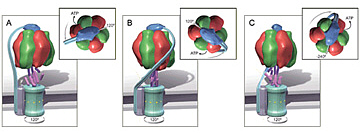
Computers make possible Blum's three-dimensional, rotating model of ATP synthase. They make possible animation that allows a viewer to travel through a simulated aorta and into the circulatory system. They allow an illustrator to experiment with 40 different perspectives or types of shading in a single afternoon, all of it reversible by a few keystrokes. "It's a huge advantage," says associate professor David A. Rini. Like most others on the faculty (which includes six full-time and 16 part-time members), Rini didn't start his career working in zeroes and ones. His first major professional project, beginning in 1990 and consuming more than two years, was a set of 400 pencil illustrations for an atlas of neurovascular surgery. He learned to work in what artists call continuous tone, which essentially means using pen, pencil, and airbrush to do gray tone illustrations. He refined a technique that combines drafting pencil and airbrushed lampblack watercolor on clay-coated board, a technique he calls "airbrush dust" and teaches at Hopkins. Though he's grown comfortable working with computers, he notes, "Very few people sit down before a blank computer monitor and start to sketch. I pick up the pencil first. There's something very tactile about sketching, about being able to see this form, letting your sketch be 'sketchy.'"
The transition to digital in medical illustration has been
a two-stage process. The first is well along: the
conversion to digital production of books and journal
articles. In the late 1990s, more and more publishers began
to request finished artwork scanned and converted to
computer files. But the production of the original
illustration remained as it had been for decades —
handwork on art boards. Then the technology became more
sophisticated, the second stage. Better software allowed
more subtle manipulation of color and effect. Along came
the Wacom tablet, an electronic slate that permits the
artist to draw freehand with a stylus. Rather than merely
scan completed artwork, illustrators now could do
everything on the computer, if they chose, or begin an
illustration by hand, scan it, then further refine it
digitally. |
| David Rini has embraced computer technology in his work but says that 70 percent of what he does is still "knowing the information, knowing the audience, and putting those two together." His illustration of conjoined twins (pictured below) visualized the surgery to separate them for audiences around the world. |
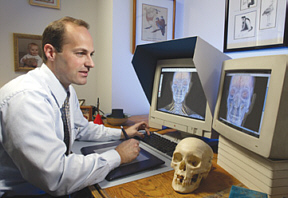 The illustrators on the Hopkins faculty seem to have taken
the technological revolution in stride. "I felt I had to
learn some new medium that had just been invented, and it
was both exciting and frustrating," Sandone says. "But it's
just a new kind of medium."
The illustrators on the Hopkins faculty seem to have taken
the technological revolution in stride. "I felt I had to
learn some new medium that had just been invented, and it
was both exciting and frustrating," Sandone says. "But it's
just a new kind of medium."Almost all artwork, no matter how it's created, now ends up as a computer file. But, says Rini, "the first 70 percent of what we do hasn't changed, whether you're using a pencil, an airbrush, or the computer. We pound this into our students. The importance of what we do is knowing the information, knowing the audience, and putting those two together. The computer doesn't do that for you."
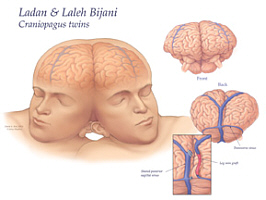
To gain sufficient understanding of anatomy or a medical procedure, the illustrators collaborate with physicians, observe actual surgery and autopsy, sometimes dissect cadavers themselves. In an operating room, Sandone will make rough pencil drawings, plus some conceptual sketches. She'll then go back to her office and sketch some more and consult with the surgeons before commencing work on a final illustration; she often works in watercolor because it's ideal for depicting wet tissues. She may later scan a painting into her computer to continue working on it digitally.
Rini, too, has logged a lot of time observing surgery and
the anatomy lab. (He teaches anatomy for the cellular and
molecular medicine program.) "You can tell if the artist
has never been in the operating room or spent much time in
an anatomy lab," he says. "There's a unique character to
the various tissues of the body, and each reacts to a
surgeon's manipulation in a slightly different way. And
there's a depth to a neurosurgical procedure, for example,
that you have to see to appreciate: They're often working
four inches deep with these long instruments, and if you
don't capture that depth, your illustration loses a lot of
credibility. It helps, too, if you have the ability to go
into a lab and actually, for example, clip an artery on a
cadaver." |
| To understand anatomy or a medical procedure, Corinne Sandone (at left) often observes a surgery, creating sketches that will serve as a basis for her final work. Below, her watercolor illustrates the anatomy of the eye, with external and bony sockets. |
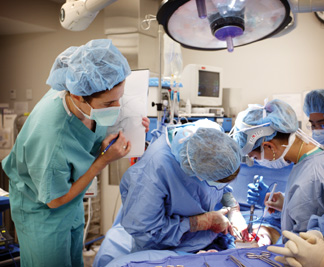 The illustrator's research also might entail a trip to the
market. Says Rini, "A surgeon comes in and says, 'I've got
this new technique for removing a lobe of the liver.'
You've seen the liver before, and you've seen this surgery
before, but say — and I'm making this up — the
surgeon now twists a lobe of the liver. I need to think,
What does liver tissue look like when you twist it? How is
that going to affect the color when the light hits it
differently? You'll see us all the time with lumps of clay,
or we'll go down to the market and get calves' liver,
whatever it takes to put this puzzle together."
The illustrator's research also might entail a trip to the
market. Says Rini, "A surgeon comes in and says, 'I've got
this new technique for removing a lobe of the liver.'
You've seen the liver before, and you've seen this surgery
before, but say — and I'm making this up — the
surgeon now twists a lobe of the liver. I need to think,
What does liver tissue look like when you twist it? How is
that going to affect the color when the light hits it
differently? You'll see us all the time with lumps of clay,
or we'll go down to the market and get calves' liver,
whatever it takes to put this puzzle together."
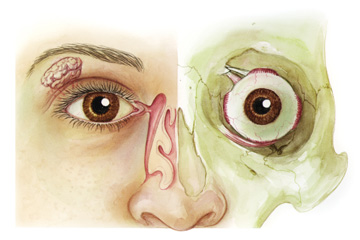
The illustrators speak of the satisfaction that arises from this sort of problem solving. Their work embodies a great deal of artistry but exists to fill a practical need. Medical and biological illustrations appear in textbooks, illustrate articles in scientific journals and popular magazines, and form or supplement exhibits in science museums. Internet Web sites devoted to patient education or advocacy on behalf of victims of various diseases use digital artwork and animation. Attorneys have learned the value of illustrations in conveying information in medical malpractice trials and other courtroom proceedings. Sandone says, "I enjoy the challenge of having a problem that needs a visual solution. To work within a structure where a problem is posed, I find I'm able to be more creative doing medical art than as a fine artist who's rendering a subject of choice and coming up with images. I like the constraints of having a story to tell." The Hopkins story began with Max Brödel, and he remains an important presence in the East Baltimore classrooms and studios. Bröat;del had grown up in Leipzig, survived smallpox, and shown early talent in music and drawing. At 16, he entered an art school with the imposing name of Die Köat;nigliche Kunstakademie und Kunstgewerkeschule zu Leipzig. The school trained him to work in charcoal, watercolor, and oils, with a German emphasis on exactitude and mastery. In Max Brödel: The Man Who Put Art Into Medicine (1991), authors Ranice W. Crosby and John Cody write: "It was part of the practical philosophy of the school that every student, in addition to acquiring the skills that established him as a creator of 'fine arts,' must also learn a utilitarian technique that would enable him, in the absence of genius, to earn a living."
In 1888, Bröat;del put this training in a utilitarian
technique to work when he was hired by Carl Ludwig, one of
the 19th century's most brilliant physiologists, to prepare
anatomical drawings. Among the scientists who were in
Germany at the time to study with Ludwig were William H.
Welch, future first dean of the Hopkins medical school, and
Franklin Paine Mall, who would become a renowned Hopkins
anatomist. In 1893, Mall convinced Bröat;del that his
future lay in the United States, specifically at Johns
Hopkins. At age 23, Bröat;del came to Baltimore,
settled into a $5-per-week room on Fayette Street, and set
to work as a medical artist, first for the Hopkins
gynecologist Howard A. Kelly. In 1911, Bröat;del, with
an endowment from Baltimore art collector Henry Walters,
founded the formal program in medical illustration. He
directed it for the next 29 years. |
| "You can tell if the artist has never been in the operating room or spent much time in an anatomy lab," says David Rini. "There's a unique character to the tissues of the body, and each reacts to a surgeon's manipulation in a slightly different way." |
In the departmental archives, currently overseen by the
87-year-old Crosby, who was Bröat;del's student and
served as director of the program for 40 years, there's a
photograph of Bröat;del standing before a bulletin
board on which are pinned dozens of drawings of human
innominate bones — hipbones. During the first weeks
of classes, every new student must fashion a
continuous-tone drawing of a hipbone. "Everyone starts with
the bone," says Gary Lees, the program's director since
1983. "It sets up a common vocabulary: how to make things
go back or come forward in space, how objects cast shadow,
detail. They choose a bone and set it up as a still life.
We start them out sketching it and have them gradually
render it until there's a bone on the board, not a
drawing." David Rini has taught in the department for 10 years and likes starting with the bone. "The students really need to understand light on form. If you don't have the concept of light on form, there's no way that a kidney's going to look like a kidney. It'll look like a flat, cutout shape. A computer is worthless if the person behind it isn't well trained in the fundamentals." He admires the artistry of Bröat;del's illustrations, which embody mastery of perspective and focal distance, and a painterly grace. "Contrary to what most people think," Rini says, "medical illustrators can allow a lot of their personalities to come through. People have the misconception that we're just copying what we see in the operating room. If you can make muscle look like muscle and be beautiful at the same time, and teach people what muscle that is, you've hit on something really satisfying. It is very difficult. If you look at any of the Bröat;del pieces, the fat looks like fat, and it's gorgeous. It just glistens on the page." Rini was a preceptor for Blum's ATP synthase computer animation project, and he admires it, too. He also admires Blum's ability to absorb the science and portray what can't be seen. Research in biochemistry and biophysics, the deciphering of the genome, and the study of physiology at the molecular level have created a concomitant need to make visual models that can't be based on observation of surgery or specimens from the anatomy lab. Blum can't go to the market to buy some sample mitochondria. But in several important aspects, physicians, scientists, and students have always needed to see what can't be seen, which is why photography has never been adequate. Photography is too indiscriminate and literal. A photograph couldn't illustrate an early step in the removal of a kidney stone, for example, with the ghosted image of the surgeon's fingers on the underside of the kidney compressing the renal blood vessels. But Max Brödel could, and did in 1910. Which means that when David Blum animated his computer model of ATP synthase, he was doing something new, but he was also doing what Hopkins medical illustrators have done for nearly a century. Dale Keiger is a senior writer at Johns Hopkins Magazine.
|
 |
|
 The Johns Hopkins Magazine | The Johns Hopkins University |
3003 North Charles Street |
The Johns Hopkins Magazine | The Johns Hopkins University |
3003 North Charles Street | Suite 100 | Baltimore, Maryland 21218 | Phone 410.516.7645 | Fax 410.516.5251 |
|